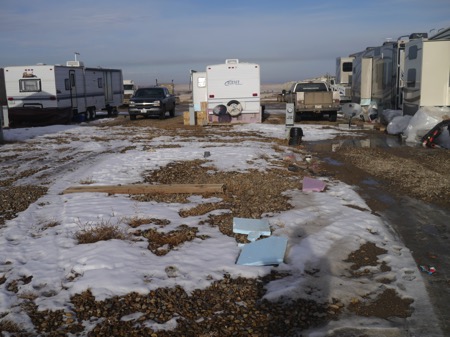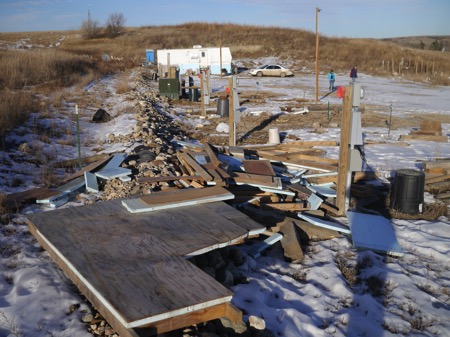After three lovely days in the Bakken, my mind is awash in ideas for research and I feel like I can start revising our submission to Historical Archaeology right away. We were once again overwhelmed by the generosity of both new and old North Dakotans. People’s patience with our sometimes intrusive requests to take photos and have conversation, their willingness to sign IRB paperwork, and their general good will makes doing research in workforce housing in the Bakken truly remarkable.

Our goals for this trip were to focus on architectural innovation in the Bakken as a way to get at issues of agency in the context of workforce housing. The reviewers of our article suggested that our famous typology (Type 1, Type 2, Type 3) was more confusing than elucidating and, to be honest, we had spent more time talking about whether a camp was Type 1 or Type 2 (or whatever) was necessary over the past few visits. So, from the start of this trip we accepted that our typology was a heuristic that was useful when we started describing workforce housing, but has become less helpful as we have come to understand it better.
In the place of our typology, we discussed how camps seem to function on a continuum from the less formal to the more formal. Less formal camps tend to have less institutional control over behavior of residents, less regular appearances, and the greater fluidity of rules and policies and their enforcement than more formal camps. The most formal camps, for example, would by those set-up and run by large companies that cater to large companies in the oil patch by strictly enforcing rules of behavior and the appearance of the camp. The least formal camps are occupied by squatters with no institutional oversight and the only limits on the structure of the camp relate to their existence outside legally sanctioned settlement.
This continuum then, from formal to informal, allowed us to describe both greater variation within the workforce housing sites in the Bakken and to understand the mechanisms that have led to this variation.
In the specific context of revising our article, shifting our focus to the “formality” of camps links our descriptions of workforce housing sites much more tightly to issues of individual agency in the physical structure of the units in the camps. Less formal camps, have greater scope for individual agency and greater variation, but nevertheless still have certain limits that dictate their organization and practices. For example, the arrangement of water, sewage, and electrical hook-ups limits the arrangement of units in the camp. Moreover, the location of the camp and its visibility to local authorities also influenced how much freedom camp residents have to innovate architecturally.
For example, we focused some of our conversations with camp residents on the practice of insulating their RVs for winter. We learned that residents of RV parks tend to learn how to insulate their RVs from their neighbors with folks who had more experience weathering the long, cold North Dakota winters, providing informal advice to those from more mild southern climes. The photograph below shows stacks of extruded polystyrene insulation prepared to be mounted around the base of a new Sandpiper RV. The unit to the right has both polystyrene and plywood insulation affixed to the base of the unit and its mudroom.

In some cases, camp managers would inspect the insulation particularly around sewage and water attachments. Some camp managers explained that if one or two units let their water or sewage freeze, they pipes throughout the camp might be compromised. As a result, they inspect sewage and water pipes regularly.



The construction of mudrooms or other forms of enclosure attached to the RV is another indication of the formality of a workforce housing site. Our favorite camp in the Bakken is Williston Foxrun which has worked hard to manage the range of architectural innovation present at the site. In its earliest days, the camp showed a remarkable variation in mudroom styles including some that exceed the size of the RV or enclosed it completely. Recently, they have worked to limit the size of mudrooms to 8 x 10, but grandfather older mudrooms built in more permissive days provided that they’re not a fire hazard or encroach on their neighbors lot. The first two photos below show relatively large mudrooms probably grandfathered through at Williston Foxrun. Both rooms have air conditioning units suggesting that they’re used for more than just taking off dirty clothes and storage. The room in the top photo also has a propane tank with lines running into the unit for either a heater or a cooktop. The last of the following three photos shows a recently built mudroom which is a good bit smaller than the 8 x 10 size limit and lacks any amenities.



Finally, we had a chance to look more carefully at discard practices at workforce housing in the Bakken. As the activity in the Bakken has shifted south and has slowed down because of the dip in oil prices, there are more and more signs of RV parks being abandoned or filled with empty lots. While some of the lots were tidy after the departure of a resident – as one of our informants noted: if he left stuff behind someone else would use it, so he might as well take it with him – other lots show signs of hasty departure or no particular concern about recycling insulation or scrap wood.



In conversation with site managers, we learned the folks left cars, personal items, mudrooms, and other scraps behind when they pulled out. Abandonment sometimes followed a period of neglect when the RV would break down, its sewage system would fail, or the occupant had come into hard times and no longer maintained his or her living space. In some cases, the resident would leave abruptly or be evicted leaving behind a mess for the camp manager but a rich assemblage for archaeological investigation. The unit pictured below showed evidence for an infant living there at least for a short period of time (a single diaper, infant sunscreen, baby lotion), but the camp manager thought the lot was just occupied by a “couple of North Dakota boys.”

So, it was a productive trip out west thanks, especially to my colleagues Bret Weber and Richard Rathaus who helped me see differently.

